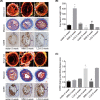Reduction of TMAO level enhances the stability of carotid atherosclerotic plaque through promoting macrophage M2 polarization and efferocytosis
- PMID: 33969376
- PMCID: PMC8176787
- DOI: 10.1042/BSR20204250
Reduction of TMAO level enhances the stability of carotid atherosclerotic plaque through promoting macrophage M2 polarization and efferocytosis
Abstract
It has been demonstrated that trimethylamine N-oxide (TMAO) serves as a driver of atherosclerosis, suggesting that reduction of TMAO level might be a potent method to prevent the progression of atherosclerosis. Herein, we explored the role of TMAO in the stability of carotid atherosclerotic plaques and disclosed the underlying mechanisms. The unstable carotid artery plaque models were established in C57/BL6 mice. L-carnitine (LCA) and methimazole (MMI) administration were applied to increase and reduce TMAO levels. Hematoxylin and eosin (H&E) staining, Sirius red, Perl's staining, Masson trichrome staining and immunohistochemical staining with CD68 staining were used for histopathology analysis of the carotid artery plaque. M1 and M2 macrophagocyte markers were assessed by RT-PCR to determine the polarization of RAW264.7 cells. MMI administration for 2 weeks significantly decreased the plaque area, increased the thickness of the fibrous cap and reduced the size of the necrotic lipid cores, whereas 5-week of administration of MMI induced intraplate hemorrhage. LCA treatment further deteriorated the carotid atherosclerotic plaque but with no significant difference. In mechanism, we found that TMAO treatment impaired the M2 polarization and efferocytosis of RAW264.7 cells with no obvious effect on the M1 polarization. In conclusion, the present study demonstrated that TMAO reduction enhanced the stability of carotid atherosclerotic plaque through promoting macrophage M2 polarization and efferocytosis.
Keywords: efferocytosis; methimazole; plaque stability; polarization; trimethylamine N-oxide.
© 2021 The Author(s).
Conflict of interest statement
The authors declare that there are no competing interests associated with the manuscript.
Figures








References
-
- Wezel A., Welten S.M., Razawy W., Lagraauw H.M., de Vries M.R., Goossens E.A.et al. . (2015) Inhibition of MicroRNA-494 reduces carotid artery atherosclerotic lesion development and increases plaque stability. Ann. Surg. 262, 841–847, discussion 7-8. Epub 2015/11/20 10.1097/SLA.0000000000001466 - DOI - PubMed
-
- Chaturvedi S., Bruno A., Feasby T., Holloway R., Benavente O., Cohen S.N.et al. . (2005) Carotid endarterectomy–an evidence-based review: report of the Therapeutics and Technology Assessment Subcommittee of the American Academy of Neurology. Neurology 65, 794–801, Epub 2005/09/28 10.1212/01.wnl.0000176036.07558.82 - DOI - PubMed
-
- Huang X.Z., Wang Z.Y., Dai X.H., Yun Z. and Zhang M. (2013) Velocity vector imaging of longitudinal mechanical properties of upstream and downstream shoulders and fibrous cap tops of human carotid atherosclerotic plaque. Echocardiography 30, 211–218, Epub 2012/10/26 10.1111/echo.12005 - DOI - PubMed
Publication types
MeSH terms
Substances
LinkOut - more resources
Full Text Sources
Other Literature Sources
Medical
Research Materials
Miscellaneous

